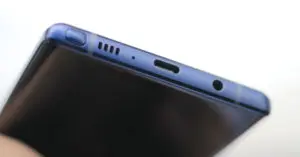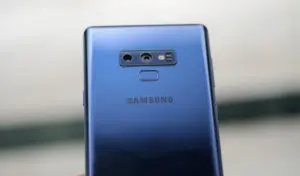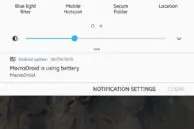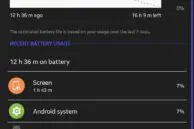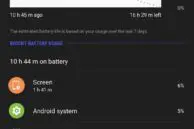The Galaxy S9 was an iterative upgrade over the Galaxy S8 with a slightly better camera, display, performance, and battery life. However, the upgrades were simply not good enough as the Galaxy S9 sales failed to meet Samsung’s expectations.
Now, the company is back with the Galaxy Note 9 which is also an iterative upgrade over the Galaxy Note 8 from last year. It is also a device which shares most of its internals and specs with the Galaxy S9. So, if the Galaxy S9 did not work the first time around, what are the chances that it will work in its second iteration as the Galaxy Note 9?
Samsung Galaxy Note 9 Review
Let’s find out in our Galaxy Note 9 review:
Design

If you have seen or used the Galaxy Note 8, you have used the Galaxy Note 9. Both handsets sport the exact same design language barring a few differences. The biggest one is at the rear where Samsung has moved the fingerprint sensor below the horizontal dual-camera setup. This makes the fingerprint scanner slightly easier to reach, though people with small hands still might find it difficult to reach. The handset is also IP68 dust and water-resistant just like its predecessor.
At the front, the Note 9 looks just like the Note 8. The bezels at the top and bottom have been trimmed slightly to accommodate for a slightly larger 6.4-inch display — vs. 6.3-inch on the Note 8. However, Samsung has increased the size of the side bezels on the Note 9. While this might not be liked by many, it does lead to a reduction in false edge presses which has always been one of my gripes with flagship Samsung devices.
The inclusion of a 4,000mAh battery means the Galaxy Note 9 is relatively heavy at 202gms. Coupled with the massive display, the Note 9 is definitely not an easy device to handle. If you are coming from a device with a particularly small display, you are definitely going to find handling the Note 9 a tough task initially.
The bottom part of the Note 9 is pretty busy and houses the USB-C port, the S-Pen slot, headphone jack, and a bottom-firing speaker. The left edge houses the clicky volume buttons, with the dreaded Bixby button sitting below it. On the opposite end of the Bixby button is the power button. The Power and Volume buttons themselves are fine but the way Samsung has positioned the dreaded Bixby button on the Note 9, I ended up accidentally pressing it while taking the phone out of my pocket or while pressing the power button.
If you can get past the size and weight of the Note 9, there’s no denying the fact that it is an impressive and beautiful piece of technology. The Gorilla Glass 5 panels at the front and rear do mean the Note 9 will attract fingerprints and pick up scratches over time, but out of the box, the device is simply stunning to look at.
Display

If you can live with the unwieldy size of the Galaxy Note 9, you will be rewarded with what is the best display on a smartphone right now. The 6.4-inch QHD+ Super AMOLED Infinity Display on the Note 9 looks beautiful from any angle you look at it.
It can get extremely bright as well as extremely dim depending on the situation. The OLED panel is laminated to the cover glass which gives an impression of the UI elements floating on top.
Display Mate in its analysis has praised the Note 9’s display in almost every key aspect, and it is all true. The Note 9’s display really has no weakness and it truly is the absolute best display panel on a smartphone right now. Samsung has even nailed down its auto-brightness algorithm so the display is able to ramp up its brightness when required or dim itself when you enter a dark room.

Software
If there’s one area where the Galaxy Note 9 falters, its software. The handset runs on Android 8.1 Oreo out of the box with Samsung Experience 9.5 skin on top of it. Samsung’s skin has come a long way from its Touchwiz days and it is now actually pretty good. Sure, it is not as pleasing to use as OxygenOS on the OnePlus 6 but its still pretty good and far better than Huawei’s Emotion UI.
It offers plenty of features and customization options like Game Launcher, support for Themes, navigation bar customizations, and more. It still does come with a number of bloatware and apps which duplicate the functionality of many of Google’s own apps.
Where Samsung falters is with its inability to implement some key features of stock Android. While the Galaxy Note 9 comes with Project Treble support, it lacks support for Seamless updates. The feature would have greatly sped up the installation of software updates on the device. Its a strange omission considering that even the $529 OnePlus 6 comes with it.
I am also completely ignoring the point that a flagship device like the Galaxy Note 9 should have ideally launched with Android 9.0 Pie out of the box. Knowing Samsung though, the Pie update for the Note 9 is not going to come before the end of this year or early next year which is a shame for a smartphone that costs $999.
S Pen

While the highlight of Samsung’s Note series is the S Pen, I am not really drawn to it. On previous Note iterations, the S Pen was only useful in a handful of scenarios and was particularly meant for artists or people who simply like doodling around on their phones. On the Note 9, the S Pen has been supercharged and it now talks to the device over Bluetooth Low Energy. This allows the S Pen to do more than what it has been previously capable of. This includes being able to use the S Pen button for various actions while inside apps. So, if you have the camera app open, you can use the S Pen as a remote shutter button. Or you can use it to even switch camera modes. Similarly, you can use the S Pen to play/pause media or skip to the next song.
If the S Pen was not what drew you to the Galaxy Note 9, its unlikely to change much after you start using the device. You will have to remind yourself that it exists so that you can use it. But in scenarios that you do get around to using it, you will find it incredibly useful.
Performance
The Galaxy Note 9 does not feel as fast as the OnePlus 6 or the Poco F1, phones which are far cheaper than it. But it is not slow either. Samsung has come a long way from the time when its phones were notorious for poor performance. I have been using the Note 9 as my daily driver for almost two weeks now and I have had no issues with its performance. Yes, it does take slightly longer to complete certain tasks than the OnePlus 6 but that’s more due to the fact that animations take slightly longer to complete on the device.
The Galaxy Note 9 will chug along at a steady pace irrespective of what you throw at it and irrespective of how many apps it has running in the background. The phone’s performance is more stable than my Pixel 2 XL which has a tendency of slowing down after a few weeks of use or on any random day. On my Pixel 2 XL, I have to keep clearing apps from the Recent Apps list every few hours to ensure the phone’s performance is not affected. The Note 9, however, has no such issues. Irrespective of how many apps I have running in the background or how hard I push the phone, it never starts lagging or exhibits any other kind of performance issues.
Despite Samsung using a bigger and more efficient cooling system on the Note 9, the handset gets warm when pushed hard even for tasks with moderate intensity. This has more to do with the Exynos 9810 chipset inside the device which is not as efficient as the Snapdragon 845 chip found inside the U.S. variant of the handset or other flagship devices. Nonetheless, this is not a cause for concern as despite getting warm, the Note 9 performs like a champ. It is just something that one must keep in mind while playing heavy games like PUBG over an extended period of time.
Camera

The Galaxy Note 9 comes with the same dual-camera setup at the rear as the Galaxy S9+ from earlier this year. This means we are looking at a primary 12MP shooter with a variable f/1.5/f2.4 aperture, 1.4um large pixel, OIS and SuperSpeed Dual Pixel AF. This is complemented by a 12MP telephoto sensor with f/2.4 aperture and OIS.
The Note 9 camera performs just like that of the Galaxy S9 which means it can take great photos irrespective of the conditions, though it does tend to overexpose them slightly. In certain aspects, the Note 9’s camera is actually slightly better than the Galaxy S9 thanks to post-processing improvements.
Thanks to its 12-frame noise reduction technology, the Note 9 is able to capture photos with astoundingly low noise and preserves plenty of details even when capturing photos in challenging situations. Samsung’s tendency to go a bit overboard with sharpening continues with the Note 9 though.
Overall, the Galaxy Note 9’s camera equals the Pixel 2 in terms of image quality.
The Live Focus feature makes use of the secondary 12MP telephoto sensor. It primarily works well in daylight and takes very average photos in low-light scenarios. It can be quite a challenge to take a Live Focus photo indoors with less than ideal lighting conditions and the resulting photos don’t turn out that impressive either.
The front 8MP camera with an f1.7 aperture applies a great deal of processing and sharpening in selfies so I am not a fan of its resulting photos. Though, if you are someone who likes using Snapchat filters on all your selfies to enhance your beauty, the Note 9 does that right out of the box for you.
While the Galaxy Note 9’s camera performance is a notch below the Pixel 2, it still offers a better package than that the Pixel. This is because of the excellent camera app and the additional features it offers. The swipe-based interface of the camera app makes it easy to switch between modes and offers plenty of options to play around with. As for additional features, the Note 9 is capable of recording Super Slo-mo videos at 960fps for 0.2/0.4 seconds, 4K videos at 60fps, and more.
Battery Life
The biggest difference between the Galaxy Note 8 and Galaxy Note 9 is terms of battery life. The former shipped with a 3300mAh battery while the Galaxy Note 9 comes with a massive 4,000mAh battery. This is the highest capacity battery used by Samsung in its flagship Note device and it shows.
The Galaxy Note 9 is easily able to make it through a day of heavy use without breaking into a sweat. It is among the very few flagship phones that is capable of lasting through a day of heavy use without requiring a top-up in the middle of the day or late in the evening.
Most days, I ended the day with almost 40 percent battery still left on my Note 9. This was after almost 3.5 hours of screen-on time and an hour of voice calls over VoLTE.
Battery life is definitely one of the strong suits of the Galaxy Note 9. Where it disappoints though is with its charging speed. While even budget Android devices have switched over to Quick Charge 3.0, Samsung continues to offer its own Adaptive Fast Charging technology on the Note 9 which offers Quick Charge 2.0-like charging speeds.
For the Note 9, Samsung has tweaked the charging process to ensure it does not slow down when the display is on. Plus, the phone pulls a constant 14-15W from the charger. Due to this, despite the bump in capacity, the Note 9 charges from 0-100 percent in the same time as the Galaxy S9 — 1 hour 40 minutes.
A phone of Galaxy Note 9’s caliber should have shipped with Quick Charge 3.0 at the very minimum. Like with almost every other flagship Samsung smartphone, the Note 9 also comes with fast wireless charging which is definitely a convenient way of charging the device when you are not in a hurry.
Conclusion

The Galaxy Note 9 is the best Android flagship smartphone you can buy right now. At $999, it definitely is very expensive but then Samsung offers plenty of goodies with the device to sweeten that deal.
The only catch with the Note 9 is its big size. If you can get over it, the handset rewards you with a beautiful display, excellent performance, and an all-day battery life. While the Note 9 is an iterative upgrade just like the Galaxy S9, it iterates in all the right and key places which makes it most perfect flagship phone to launch this year.
If money is not an issue for you and you are looking for the absolute best Android smartphone, look no further than the Galaxy Note 9.
If you have already purchased the Galaxy Note 9, then we would love to hear your thoughts in the comments section.
Note: Rajesh Pandey also contributed to this Galaxy Note 9 review.

